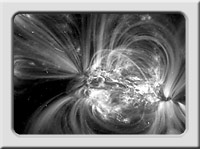UC Berkeley Web Feature
Inspiration from the sun
BERKELEY –The Space Sciences Laboratory (SSL) hosted three artists-in-residence last year through an Art and Space Science Fellowship sponsored by the Arts Council England International Artists Fellowship Programme. Aimed at artists in the United Kingdom working on the edge of science and technology, it brought to the lab last summer Liliane Lijn, who makes light and motion sculptures, and in the fall and winter, British performance artists Ruth Jarman and Joseph Gerhardt, who together form the group Semiconductor.
| Brilliant Noise from space |
 View Semiconductor's performance pieces composed at UC Berkeley's Space Sciences Laboratory |
"We felt like we arrived in the middle of a story, and we had to figure it out," Jarman said, noting that research physicists Ilan Roth and Forrest Mozer helped introduce them to space scientists and to the solar and space research going on at the lab. They later captured many of these scientists on film answering questions such as, "Do you think science will be able to explain everything?"
Jarman and Gerhardt had used space sounds, such as radio signals from Jupiter, in their work before, but only as a source of noise.
"The reason we called ourselves Semiconductor 10 years ago is we work a lot with a computer. We are semi-conducting, we are only half in control," she said. "Ever since then, we have embraced the idea of working with white noise. Our earlier piece of work using space sounds was meant to be about the origins of the universe, and about it growing over time, although when you watch it you have no idea that's what's going on."
SSL scientists introduced them to the science behind the "noise," including actual radio recordings of the solar wind and images of the sun's activity captured by satellites such as SOHO and Trace and ground-based telescopes such as Big Bear Solar Observatory. The images are close-ups of sunspots, flares, prominences and coronal mass ejections all the more impressive for their size – many are larger than the Earth.
"Our idea was to use the actual sound recordings of the sun, but they are limited in their frequency, like a low rumble," said Gerhardt. "We wanted more diversity, so we took that idea of radio bursts and exaggerated it, using the brightness of the image to control the loudness."
The result, though not yet finished, was "Brilliant Noise," which was previewed for SSL scientists Jan. 12, just before Jarman and Gerhardt returned to England. While it's not clear whether the scientists knew what to make of the piece or of the "fictional documentary" the artists created from interviews with scientists at the lab, Jarman and Gerhardt plan to utilize what they've picked up in future installations.
"We have learned a lot of science being here, something we will carry on investigating, specifically the area of science they are studying here, which is the sun-Earth connection," Jarman said. "It's given us a really good focus for our science interests."

